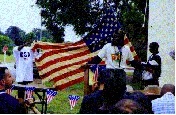National Homeless Plan Initiative
A Basic Blue Print
by Ted Hayes
Civil Rights-Homelessness Resolution Activist

You are welcome to obtain a detailed copy of the National Homeless Plan to peruse and study at your leisure. If you have different ideas or views that you believe would be more effective in eradicating homelessness, please let us know - we would be thrilled to hear them! Feel free to email us at : Ted@TedHayes.us
In brief summary, the National Homeless Plan - also known as the Exodus/Genesis Initiative/Incentive Plan (EGIIP) - calls for the President of the United States to take two basic actions. They are:
First, enact an Executive Order that would adopt and implement a plan and strategy to eradicate homelessness as we see and know it today throughout America beginning in Los Angeles, the official homelessness capital of our nation. From implementation through completion, the planned operation is designed to fulfill itself within a 5 to 10 year period.
In order to move swiftly, by-passing Congress, the President, appoints a cabinet-level Commissioner of Homeless (COH) czar empowered for the primary task of coordinating a National Homeless Commission (NHC).
The empowerment of this czar will allow him/her direct access to the President, and/or Vice President, and/or National Security Advisor, or any relevant involved member of the President's cabinet.
Under the plan, the National Homeless Commission will be charged with adopting and developing programs and strategies derived from 'the people' of the United States of America. The Commission will also take part in making the necessary legislative recommendations to both the President and Congress.
Second, the US President is now empowered to "bully-pulpit" Wall Street interests into investing in the EGIIP with the obvious expectation of remuneration. These steps will lead to the implementation of an agenda with the ultimate objective of putting deals in place and strategizing components which are specifically laid out in the National Homeless Plan.
The elements of the agenda include creating effective training methods and developing incentives for the urban Homeless to relocate to less populated areas in order to regain self-societal worth and become productive citizens through active economic, political and social participation.
Each element of the agenda requires the National Homeless Commission to also develop the means by which every program can be funded - not by tax dollars-Congress, - but, rather, by partnerships with those whose business interests are served.
One prominent idea, for example, is to develop portions of abandoned military bases into greater "alternative tributaries" and new chartered townships.
These new chartered townships are essentially residential/industrial enterprise centers where former homeless people will be afforded the opportunity to begin again.
The townships would be staffed by a Domestic Peace Force whose personnel are committed to spending a minimum of two years working and residing within the community alongside other non-homeless persons, such as individuals and families willing to amalgamate with the former homeless populations.
Enterprise-partnering business interests will benefit by contracting for the production of products and/or services, and by observing the functioning of the new milieus as alternative business models. Actually, manufacturers can "in-source" to these new townships and not necessarily pay minimum wages, because by Presidential decree, the cost of living there will be far less than in cities such as Los Angeles.
Every element of the National Homeless Plan's implementation must necessarily present the kind of humane values that make this country great, and must reject solutions which opt in favor of the fascism which has always been our country's enemy.
The National Homeless Commission will also be required to identify and to accommodate, as fully as possible, points of shared self interest among elements of government, business, local communities, the Homeless, and the people.


